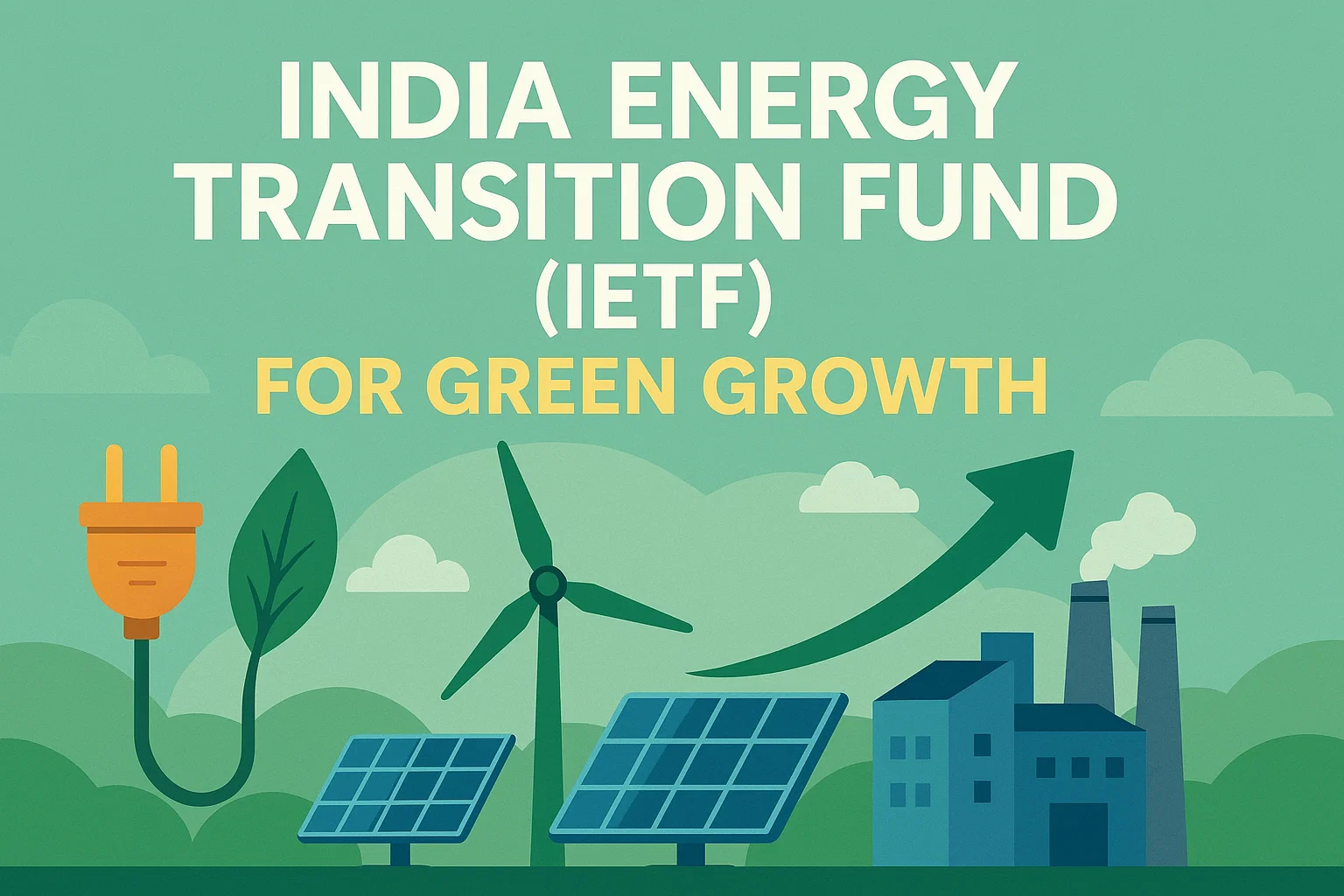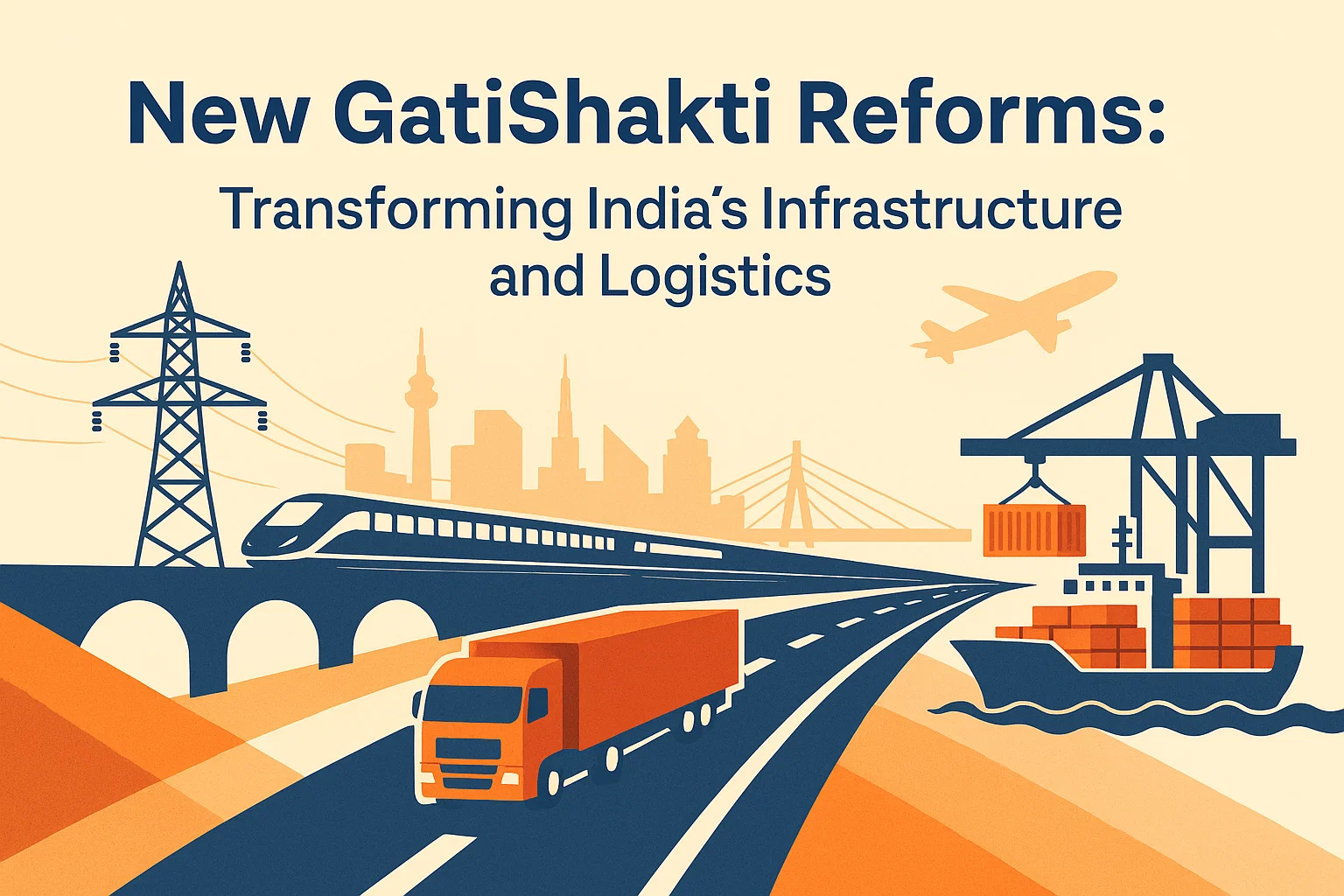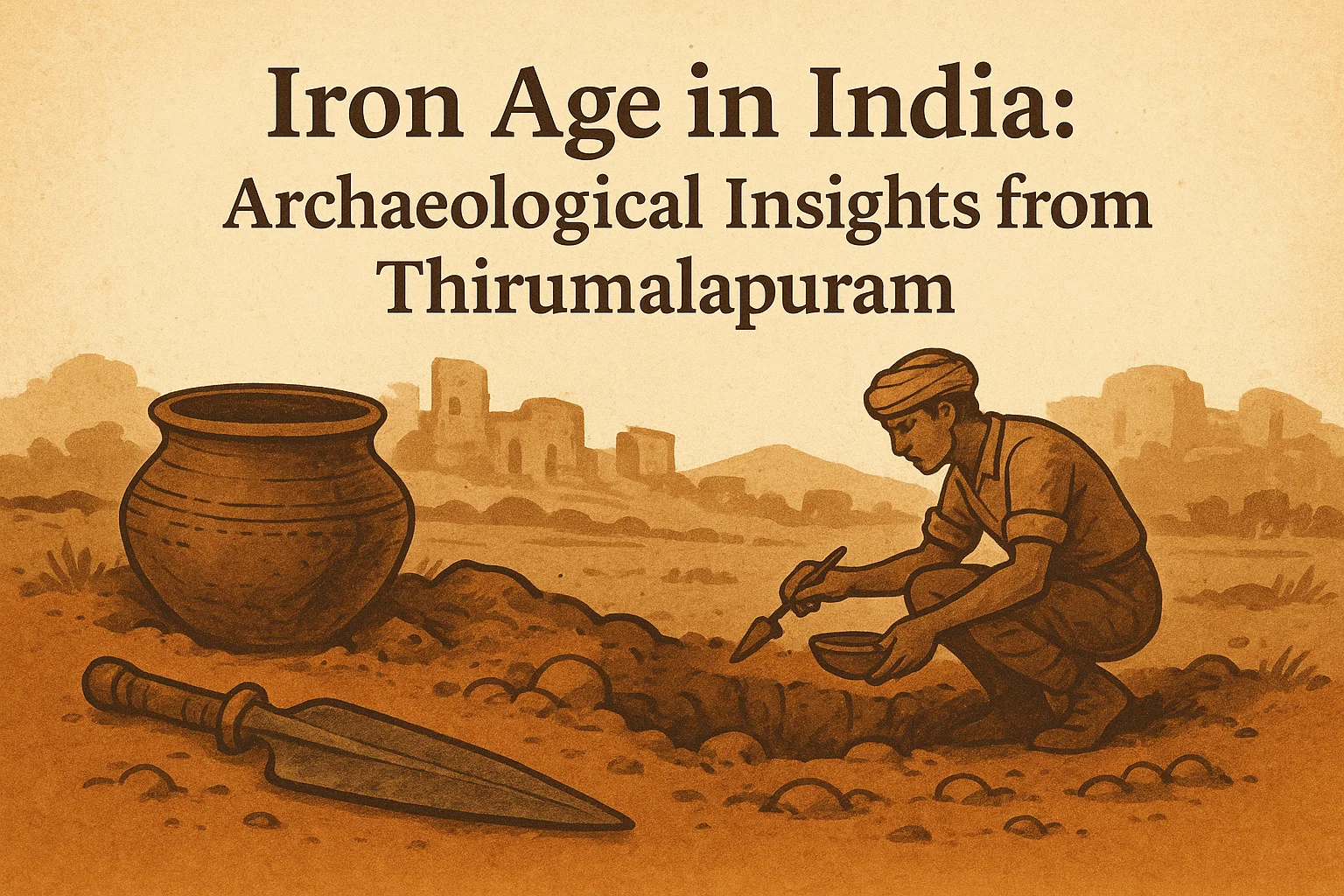Daily Current Affairs 12th July 2025
In today’s current affairs roundup, we explore crucial national and environmental issues shaping India’s present and future. From custodial deaths raising questions about policing in Tamil Nadu to India’s strides in equality, electoral integrity, and social reforms—this edition also brings attention to climate-driven disasters and innovative tribal empowerment initiatives. Here are the key topics we cover today:
1) Custodial Deaths and Tamil Nadu’s Police Stations
2) India as One of the Most Equal Countries
3) India’s Electoral Process
4) Aiding India’s Progress with Bold Reforms in Education, Health and Autonomy
5) Climate Change-Induced Floods in Himachal Pradesh: Causes, Impacts, and Mitigation Strategies
6) Heat Domes and the Rising Threat of Extreme Heat
7) TALASH (Tribal Aptitude, Life Skills and Self-Esteem Hub)
Custodial Deaths and Tamil Nadu’s Police Stations
End custodial brutality, begin criminal justice reform
Context: The recent custodial death of Ajith Kumar, a 27-year-old temple guard from Sivaganga, is not a rare exception—it is part of a recurring pattern that raises urgent questions about policing and accountability in India.
More Cases
Ajith’s death joins a growing list of disturbing cases:
- Vignesh (2022): A 25-year-old detained in Chennai, died within hours. Post-mortem showed multiple injuries.
- Raja (2024): A Dalit cook from Villupuram, died in custody after a petty theft allegation. His family still awaits compensation.
- Unnamed auto driver (2023): Died under suspicious circumstances in Tiruchi.
Has the Use of Force Become Normalised in Indian Policing?
- Custodial violence is no longer an aberration—it is fast becoming institutionalised.
- The normalisation of brutality reflects a larger crisis: a state that invests in enforcement but neglects reform.
- Tamil Nadu, for instance, allocates thousands of crores to policing every year. But how much goes toward officer welfare, mental health, or ethical training?
- The current allocation heavily favours hardware—vehicles, surveillance systems, and riot gear—over human development.
- Officers are armed with batons and law books, but lack the tools to manage stress, trauma, and ethical dilemmas.
- Policing must move beyond control and coercion. It must embody conscience, care, and constitutional morality.
What Reforms Can Address Custodial Violence in Tamil Nadu?
- A reallocation of even 5% of the police budget toward officer wellness and training could transform policing outcomes:
-
- District-level mental health units
-
- Mandatory quarterly counselling
-
- Regular human rights and ethics sensitisation courses
- Without emotional and psychological support, burnout often turns into brutality.
- When a constable handles a domestic violence case in the morning, gang violence by noon, and political complaints by night, the accumulated pressure often erupts in harmful ways.
How Can Police Training Be Reimagined for Modern India?
- The existing police training curriculum, largely unchanged since the pre-liberalisation era, is outdated.
- It must be restructured to include Ethics and empathy, Human rights jurisprudence, Trauma-informed investigation practices and Community policing models.
-
- Such training should not be symbolic but institutional and enforceable.
What Legal and Technological Steps Can Ensure Police Accountability?
Justice cannot rely on post-incident suspensions or internal inquiries. India urgently needs a comprehensive anti-custodial violence law with:
- Time-bound investigations
- Mandatory video documentation of all interrogations
- Civil society involvement in oversight
- Operational, tamper-proof CCTV systems
- Real-time digital audits
- Technology must be a tool for transparency, not a silent witness to abuse.
India as One of the Most Equal Countries
Govt claims on reducing inequality in India
Context: A recent government press release made bold claims about India’s income equality, citing the World Bank’s latest Poverty and Equity Brief.
More on News
- According to it, India is not only the world’s fourth-largest economy but also the fourth most equal society globally, with a Gini Index of 25.5—behind only the Slovak Republic, Slovenia, and Belarus.
- However, this declaration has sparked intense criticism from economists and inequality researchers, who argue that the reality on the ground is far more complex and troubling.
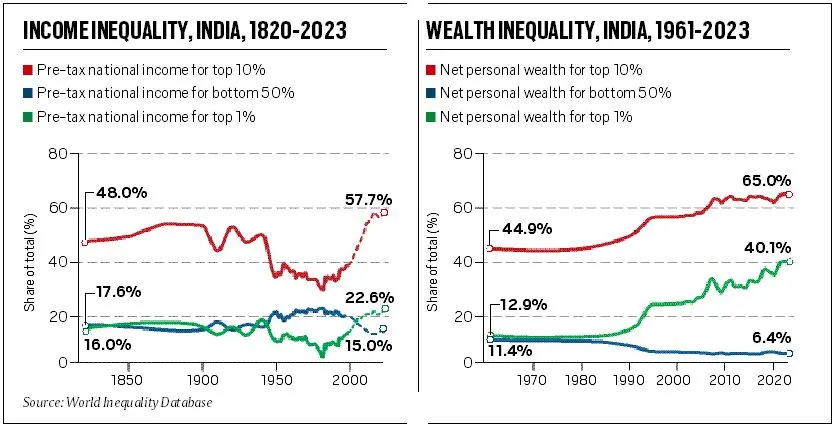
What Does the Gini Index Actually Measure?
- The Gini Index, or Gini coefficient, is a widely used measure of income or wealth inequality.
- It ranges from 0 (perfect equality) to 1 (perfect inequality).
-
- A lower Gini score signifies a more equal society.
- However, what matters is how this number is calculated.
- In India’s case, the Gini Index is based on consumption data—not income—which significantly alters the true picture of inequality.
Why Is the Government’s Gini-Based Equality Claim Misleading?
- The World Bank report cited by the government does state that India’s Gini Index improved from 28.8 in 2011-12 to 25.5 in 2022-23. However, it also includes a critical caveat: “Inequality may be underestimated due to data limitations.”
- What the government omitted is the World Inequality Database (WID) figure, which shows a dramatic increase in income inequality—from a Gini of 52 in 2004 to 62 in 2023.
- The consumption-based Gini offers a far rosier view than the income-based Gini because income disparities are usually much higher than consumption disparities.
- As high earners tend to save or invest a larger part of their income, this additional wealth is not captured in consumption surveys, thus underreporting inequality.
Why Is Consumption-Based Data Problematic for Measuring Inequality?
- India relies on consumption surveys instead of income surveys to assess economic inequality. This presents multiple problems:
- Lower variation in consumption than income masks the wealth gap.
- As people earn more, much of their income goes into savings or investments, not consumption.
- This leads to a systematic underestimation of inequality.
- Comparing India’s consumption-based Gini to income-based Ginis in other countries is not methodologically valid.
Is the Gini Index Sufficient to Capture Economic Inequality?
While the Gini Index remains popular, it has critical flaws:
- It is insensitive to extremes (top 1% vs. bottom 50%).
- It is too sensitive to changes in the middle of the distribution.
- An alternative measure like the Palma Ratio, which focuses on the top 10% vs. bottom 40% or 50%, offers a clearer picture of disparity at both ends.
- Using such measures in India reveals alarming inequality trends, with the top 1% earning far more than the bottom 50%.
What Are the Policy Risks of Misreading Inequality in India?
- Underestimating inequality can lead to ineffective or even harmful policies. If the state believes the economy is equitable, it may: Ignore redistribution measures, Underfund social security schemes and Neglect inclusive growth.
- Unchecked inequality can worsen social unrest, reduce trust in institutions, and even stall long-term economic growth.
- Therefore, using limited metrics like a consumption-based Gini Index without transparency or accounting for limitations can mislead public discourse and governance priorities.
India’s Electoral Process
Context: In an era where electoral roll revisions, like the one currently underway in Bihar, are raising concerns about disenfranchisement, it’s crucial to recognise the extraordinary efforts of the Election Commission (EC) in ensuring that every vote counts — quite literally.
How Many People and Resources Power India’s Elections?
- India’s 2024 general election saw the deployment of: 978 million registered voters, 1.2 million polling stations, 5.5 million EVMs (Electronic Voting Machines), 15 million personnel (including polling officials and security) and Over 4 lakh vehicles, 1,700 air sorties, and 135 special trains.
- From helicopters and boats to elephants and mules, India uses every transport means imaginable to deliver the vote to the doorstep of every eligible citizen.
How Does India Reach Its Most Remote Voters?
India’s electoral commitment stretches across terrain as diverse as its population:
- Tashigang, Himachal Pradesh: The world’s highest polling booth at 15,256 feet, serving just 65 voters, braving -35°C temperatures and thin air.
- Indira Point, Great Nicobar Island: Over 1,400 km from mainland India, this booth is closer to Indonesia than Delhi.
- Warshi, near Siachen Glacier: A 180-km journey from Leh ensures five voters don’t travel more than 2 km.
- Gir Forest, Gujarat: Until 2019, a booth was set up for just one voter, Bharatdas Darshandas, inside lion territory.
What Makes India’s Electoral Infrastructure So Robust?
India’s electoral supply chain includes:
- EVMs and VVPATs (Voter Verifiable Paper Audit Trails)
- Indelible ink, seals, voter slips, PPE kits, tents, and signage
- GPS-monitored strongrooms for EVM storage
- Solar panels, battery banks, and diesel generators in off-grid areas
- Real-time dashboards, encrypted VPNs, and mobile apps for data tracking
- Every polling station is backed by a fail-safe system — ensuring uninterrupted voting, even in extreme conditions.
How Is Security and Transparency Ensured in Indian Elections?
- Security and integrity are at the heart of the electoral supply chain:
- Over 1.6 lakh sensitive booths are protected by CAPF, state police, and Home Guards
- EVMs are barcoded, dual-locked, and CCTV-monitored
- The cVIGIL app enables citizens to report violations, with most complaints resolved in under 100 minutes
- Mock polls, VVPAT audits, and digital asset tagging help ensure quality control and transparency
- Even waste management protocols are strictly followed, ensuring that polling stations leave behind zero trash.
How Does India Compare Globally in Election Management?
Unlike many developed democracies that face last-mile failures, India excels:
- Nigeria (2019): Presidential polls postponed due to delayed delivery of election materials.
- UK, US, Australia: Instances of ballot shortages turning voters away.
- In contrast, even India’s most isolated booths operate on time, with full supplies and contingency systems. This isn’t just logistics — it’s constitutional commitment in action.
Aiding India’s Progress with Bold Reforms in Education, Health and Autonomy
Aiding India’s Progress: Unlocking Youth Power Through Choice and Opportunity
Context: With the global population now over eight billion, it is vital to focus on vulnerable groups, especially the youth. The 2025 World Population Day theme — “Empowering young people to create the families they want in a fair and hopeful world” — highlights the need to ensure their right to accurate information, education, and freedom of reproductive choice.
Who is at the center of India’s development focus and why?
India’s youth population is at the core of national development.
- According to UNICEF, India has 371 million people aged 15–29 years — the largest youth population globally.
- This group holds transformative potential. If supported with education, health, skills, and agency, it can boost India’s GDP by up to $1 trillion by 2030 (World Bank & NITI Aayog projection).
- However, without adequate investment and systemic reform, this potential risks being wasted.
What are the major challenges faced by India’s youth, especially young women?
- Limited reproductive autonomy: According to the UNFPA State of World Population Report 2025,
- 36% of Indian adults face unintended pregnancies.
- 30% report unmet reproductive goals.
- 23% face both.
- High prevalence of child marriage: Though halved since 2006, it remains at 23.3% nationally (NFHS-5, 2019–21).
- Teenage pregnancies: 7% of women aged 15–19 have borne children — with state-level disparities doubling that figure in places.
- Socio-cultural barriers: Gender inequality, early marriage pressures, and poor access to SRH (Sexual and Reproductive Health) information and services remain deeply entrenched.
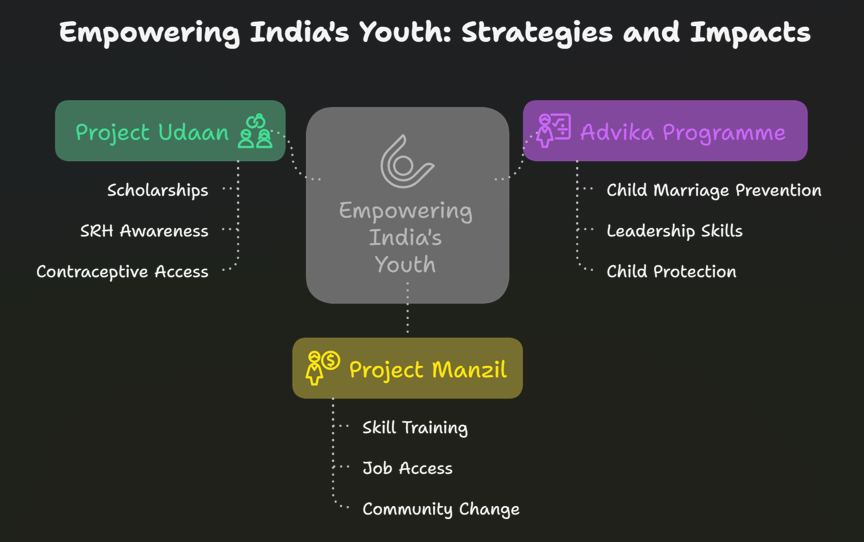
Where are the regional disparities most evident?
- Teenage childbearing: While 7% is the national average, certain States exceed 14% (NFHS-5).
- Child marriage: Some districts in states like Bihar, West Bengal, Rajasthan still show 30–40% prevalence.
- Access to services like contraception, secondary education, and skilling opportunities varies significantly across States.
How can India accelerate youth-led development and empowerment?
India must take a rights-based, multi-sectoral approach:
- Expand universal access to contraception, SRH services, safe abortion, infertility care.
- Tackle structural barriers — such as lack of education, housing, childcare and workplace flexibility.
Why is reproductive autonomy and youth empowerment crucial for India?
- It reduces early pregnancies, improves maternal and child health, and delays marriage — all linked to better educational and economic outcomes.
- According to UNICEF, each additional year of secondary education reduces the risk of child marriage by 6%.
Empowered girls have greater voice and agency, better negotiation power, and contribute to inclusive development.
- Scale up cash transfer programmes, community mobilisation, and gender-responsive skilling.
- Promote youth participation in decision-making at policy and community levels.
What does the global framework say?
The 1994 International Conference on Population and Development (ICPD) set global goals:
- Right to make informed choices about sexual and reproductive health.
- Freedom from coercion, discrimination, and violence.
- UN’s World Population Day 2025 theme reaffirms this with the call.
NITI Aayog suggests reduced ‘core’ grant support for State S&T bodies
Lateral Entry Push to Boost State Science Governance
Context: Amid concerns over lack of motivation and expertise among state science secretaries, Union Minister Jitendra Singh has proposed lateral entry of scientists into top S&T roles in states. Simultaneously, the NITI Aayog has recommended shifting from core grant funding to project-based support for State S&T Councils, as outlined in its July 2025 report.
What does the NITI Aayog recommend in its 2025 report on S&T Councils?
- Governance and Staffing Reforms:
- Hire full-time Executive Directors with scientific experience
- Maintain a 70:30 ratio of scientific to non-scientific staff
- Build career progression pathways for scientific staff
- Financial Reforms:
- Cut “core grants” from DST and move to project-based funding
- Each state should allocate at least 0.5% of GSDP for S&T activities
What national benchmarks support the case for reform?
- India’s Gross Expenditure on R&D (GERD) is only around 0.7% of GDP, far below countries like Israel (5.4%) or South Korea (4.8%) — (UNESCO Institute for Statistics, 2023).
- 85% of India’s research output is attributed to Central institutions (NITI Aayog, 2025), while State S&T institutions lag behind in publishing or patenting.
- Only 14 states have implemented a State S&T Policy, most of which are outdated or inactive.
-
Structural and Strategic Suggestions:
- Improve linkages with state-funded universities and local industries
- Encourage collaboration with PSUs and private R&D
- Reduce dependency on Central grants by tapping other central project-based schemes.
Who currently heads the S&T departments in most states, and what is the problem with that?
- Currently, Indian Administrative Service (IAS) officers are typically appointed as Science and Technology Secretaries at the state level.
- This setup leads to:
- Low motivation and lack of ownership of scientific progress
- Administrative leadership without technical or research experience
- Stagnation in initiating or sustaining innovation-driven policies
What is the proposed solution to address leadership gaps in State S&T Councils?
-
- The Union Government, led by MoS Jitendra Singh, is considering lateral entry of qualified science professionals into the post of State S&T Secretaries.
-
Key Aspects of Lateral Entry:
-
- Scientists or science administrators with domain expertise and administrative exposure
- Recruitment via a merit-based fixed-term process
- Similar to earlier central lateral entry recruitments conducted through DoPT and UPSC
- Lateral entry in civil services was institutionalised in 2018 when nine professionals were inducted into Joint Secretary-level posts in various ministries.
Why is there a need for lateral entry in the S&T domain specifically?
- The S&T landscape is evolving rapidly, driven by fields such as AI, climate tech, space, biotech, and quantum computing. Traditional bureaucratic approaches often lag behind scientific needs and lack agility in engaging with research institutions, startups, or industrial R&D.
- Key Justifications:
What are some examples or case studies that highlight the problem or potential solutions?
- Positive Example – Kerala State Council for Science, Technology & Environment (KSCSTE):
- Despite no Central DST support, the council manages a ₹173 crore budget
- Strong engagement with universities and climate research
- Conducts programs like young innovator fellowships, patent facilitation, and marine research
- Negative Example – States with Budget Cuts:
- Uttarakhand (-5%) and Tamil Nadu (-4%) have had delays in key projects, including disaster-tech labs or AI hubs in agriculture
- Absence of lateral entry or project-based flexibility has led to under-utilisation of Central schemes
- Better alignment of State S&T policies with national missions like National Quantum Mission, National Research Foundation, etc.
- Bridge the gap between policy-making and scientific execution
- Avoid misallocation of portfolios to unwilling or untrained officers
How do funding patterns currently affect the efficiency of State S&T Councils?
-
- The funding model is highly skewed:
- Minimal DST support: Gujarat (₹1.07 cr out of ₹300 cr), Kerala (₹0 from Centre)
- Budget disparities across states: While Maharashtra saw a 130% rise, states like Sikkim, TN, and Uttarakhand saw cuts
- Inability to tap into project-based grants from ministries like MNRE, MoEFCC, etc.
-
Consequences:
-
- Sluggish project execution
- Weak capacity to innovate
- Limited participation in the national R&D ecosystem.
How will lateral entry and institutional reform help India’s larger S&T ambitions?
- India is aiming to become a top 3 global innovation hub by 2047. Strengthening state-level S&T ecosystems through lateral entry and structural reforms will:
- Boost grassroots innovation aligned with local needs
- Ensure faster tech adoption in sectors like agriculture, climate resilience, and healthcare
- Promote research diversity beyond central hubs like IISc, IITs, or CSIR labs.
Climate Change-Induced Floods in Himachal Pradesh: Causes, Impacts, and Mitigation Strategies
Himachal floods: How can Himalayan region safeguard its people, heritage, ecosystems from climate change?
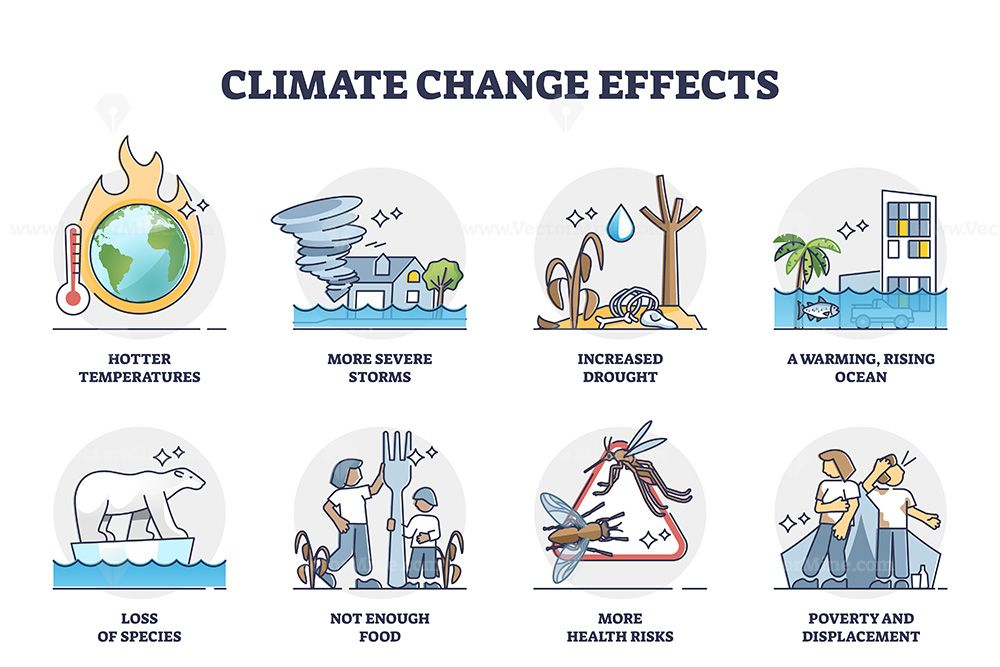
Context: Recent floods in Himachal Pradesh’s Mandi, Kullu, and Chamba districts highlight the growing threat of extreme weather in the Himalayas. Cloudbursts caused landslides, infrastructure damage, and major economic losses, underscoring the urgent need for climate-resilient adaptation in mountain regions.
Why is the Himalayan Region Facing Increasing Floods?
- Climate Change and Increased Atmospheric Moisture: Global warming raises Earth’s temperature, allowing the atmosphere to hold 7% more water vapour per °C increase. Leads to heavier, more intense rainfall, causing frequent cloudbursts and flash floods.
- Rapid Glacier Melting: Himalayan glaciers are losing up to 30 metres of ice thickness annually. Increased water flow in rivers (Beas, Yamuna, Ganges) raises flood risks during monsoons.
- Erratic Monsoon Patterns: Climate change alters timing and intensity of monsoons. Some regions face early, heavy rainfall, while others suffer delayed or deficient monsoons, leading to both droughts and floods.
- Vulnerable Himalayan Topography: Steep slopes funnel rainwater rapidly into valleys, increasing flood intensity. Unstable terrain predisposes landslides, worsening flood impacts.
What Are the Socio-Economic Consequences?
- Economic damage: Exceeds ₹700 crore.
- Loss of life: Several fatalities reported due to sudden cloudbursts and landslides.
- Agriculture: Massive destruction of farmland due to soil erosion and sediment deposition.
- Infrastructure: Roads, bridges, and communication lines were severely damaged, cutting off communities.
- Displacement: Thousands forced from their homes, facing food shortages and livelihood losses.
How Can the Himalayan Region Adapt and Mitigate Flood Risks?
- Infrastructure Resilience: Build climate-resilient infrastructure: durable roads, bridges, and flood defences. Use local geology and hydrology in planning to reduce risk.
- Sustainable Land-Use and Water Management: Promote afforestation and slope stabilisation. Create reservoirs and rainwater harvesting systems to regulate flow and reduce flood peaks.
- Early Warning and Community Preparedness: Install advanced early warning systems. Conduct community-based disaster preparedness and public education campaigns. Train local residents for effective flood response.
- Climate-Smart Agriculture: Adopt flood-tolerant crops, shift planting schedules, and use soil conservation techniques. Improve food security and reduce economic losses.
- Sustainable Policy and Environmental Restoration: Shift towards renewable energy to reduce greenhouse gas emissions. Protect and restore wetlands and forests as natural flood buffers.
What’s the Way Forward?
- Only a proactive, integrated, and inclusive approach—combining infrastructure, environmental policy, technology, and local engagement—can reduce vulnerability and foster long-term resilience.
- Coordinated action at global, national, and community levels is vital to safeguard lives, livelihoods, and the fragile Himalayan ecology from the escalating threats of climate change.
Heat Domes and the Rising Threat of Extreme Heat
Life-threatening heat domes challenge forecasters amid climate change
Context: In June 2025, the eastern United States experienced record-breaking temperatures that triggered power emergencies and raised concerns about public health and infrastructure. The culprit: an enormous heat dome, a high-pressure system that traps scorching air over a region, creating stagnant, sweltering conditions.
More on News
- This summer, heat domes haven’t just struck the US — similar phenomena have already hit Europe, forcing the temporary closure of the Eiffel Tower, and China, where concerns over wilting rice crops have emerged.
- While relatively easy to identify once they’re underway, heat domes remain notoriously difficult to forecast, posing a growing challenge in an increasingly warming world.

What Is a Heat Dome?
- A heat dome occurs when a high-pressure system stalls over a region, trapping hot air beneath it. With little cloud cover and stagnant air, the sun’s energy intensifies the heat, creating a self-reinforcing cycle. Think of it as a lid on a pot—once sealed, the heat builds and builds.
- Unlike typical heat waves, heat domes can linger for days or even weeks, pushing temperatures to record-breaking levels and straining everything from power grids to public health systems.
Why Are Heat Domes Becoming More Common?
- Climate change is the key driver. As greenhouse gases trap more heat in the atmosphere, the conditions that foster heat domes—like weakened jet streams and dry soil—are becoming more frequent and intense.
- Jet stream disruption: Arctic warming weakens the temperature gradient between the poles and tropics, causing the jet stream to kink and stall, locking heat domes in place.
- Surface warming: With the planet nearly 1.5°C warmer than pre-industrial levels, heat domes today are hotter and more intense than ever before.
The Impact of Heat Domes
- Health risks: Heat-related illnesses like stroke, heart failure, and dehydration spike during heat domes. In 2022, over 61,000 deaths in Europe were linked to extreme heat.
- Economic damage: From 1980 to 2024, wildfires and droughts—often triggered by heat domes—caused over $500 billion in damages in the US alone.
- Infrastructure strain: Rail tracks warp, airliners lose lift, and wind turbines underperform in the dead, hot air.
- Agriculture under strain: Heat domes stress crops like corn, soybeans, and rice, threatening food security. Prolonged heat reduces yields, increases irrigation demands, and disrupts planting cycles.
Forecasting Challenges
- Unlike El Niño or polar vortexes, heat domes are hard to predict. Meteorologists rely on:
- Global Atmospheric Angular Momentum (GLAAM) to track jet stream behaviour
- Soil moisture levels—drier land means higher temperatures
- Statistical modelling of past patterns and emerging trends
- Despite these tools, lead times remain short, making early warnings difficult.
Mitigation and Adaptation
- While reducing emissions is the long-term solution, cities and nations must also adapt:
- Urban cooling: Green roofs, tree cover, and reflective surfaces can reduce urban heat islands.
- Energy resilience: Smart grids and distributed energy systems help manage surging demand.
- Agricultural shifts: Adjusting crop types, irrigation schedules, and planting seasons builds resilience.
TALASH (Tribal Aptitude, Life Skills and Self-Esteem Hub)
TALASH Initiative Set to Foster Holistic Excellence Among Eklavya Model Residential Schools Students
Context: The National Education Society for Tribal Students (NESTS), under the Ministry of Tribal Affairs, in collaboration with UNICEF India, has launched TALASH — Tribal Aptitude, Life Skills and Self-Esteem Hub.
What is TALASH?
-
- TALASH symbolises a focused “search” for self-awareness, life skills, and career clarity among tribal youth.
- The initiative aligns with the National Education Policy (NEP) 2020, focusing on holistic and inclusive education.
- Objective: To support the all-round development of tribal students in Eklavya Model Residential Schools (EMRSs)
- Expected Reach: TALASH seeks to empower over 1.38 lakh tribal students across 28 States and 8 Union Territories.
- The initiative is being rolled out in phases across select cities to ensure a smooth and inclusive implementation. By the end of 2025, TALASH is expected to be fully operational in all EMRSs nationwide.
Eklavya Model Residential Schools (EMRS)
- Purpose & Vision: Designed to provide free, quality residential education to Scheduled Tribe (ST) students from Class VI to XII in remote areas.
- EMRSs are set up in blocks with over 50% ST population and at least 20,000 tribal residents.
- As of now, 708 schools have been sanctioned, with 405 functional. Each school accommodates 480 students (equal number of boys and girls).
- Expansion plans include 728 schools by 2026 and 15 Centres of Excellence for Sports. Integration of technology-enabled learning, including online tutoring for IIT/NEET, smartboards, and DTH education.
Key Features of TALASH
- Psychometric Assessments: Based on NCERT’s ‘Tamanna’ initiative, TALASH introduces a common aptitude test. Students receive personalised Career Cards based on their test results, offering suggestions aligned with their skills and interests.
- Career Counselling: Students are guided to make informed career choices, aligning their aspirations with aptitude. Counselling is designed to address both mainstream and alternative career pathways, ensuring inclusivity.
- Life Skills and Self-Esteem Modules: TALASH provides training in problem-solving, communication, decision-making, and emotional regulation. Modules are geared toward enhancing confidence, self-worth, and social adaptability.
- E-Learning for Teachers: A specialised e-learning portal equips EMRS teachers with the skills and tools needed to guide students. So far, 189 teachers from 75 EMRSs have been trained and are actively conducting school-level training sessions.
Additional Initiatives Linked to TALASH
-
- Exam Coaching & Employment Training: NESTS has signed two MoUs:
- With Tata Motors: For skill development and employment opportunities for Class 12 graduates.
- With Ex-Navodayan Foundation: For competitive exam coaching (e.g., IIT-JEE, NEET).
- Exam Coaching & Employment Training: NESTS has signed two MoUs:
-
Adi Karmyogi Programme:
-
- Launched by the Tribal Affairs Ministry in Bengaluru on July 10, 2025.
- Objective: To build a motivated cadre of field officers using a citizen-centric, delivery-oriented approach.
- Targets capacity building of 20 lakh stakeholders through a tiered training model: 180 State-level trainers, 3,000+ District-level trainers, 15,000+ Block-level trainers.
About the Partner Organisations
- NESTS (National Education Society for Tribal Students): An autonomous body under the Ministry of Tribal Affairs. Responsible for quality education to tribal students through the EMRS network across India.
- UNICEF India: Part of a global organisation active in over 190 countries. Dedicated to promoting children’s rights and well-being, with a focus on education, health, and protection.
Subscribe to our Youtube Channel for more Valuable Content – TheStudyias
Download the App to Subscribe to our Courses – Thestudyias
The Source’s Authority and Ownership of the Article is Claimed By THE STUDY IAS BY MANIKANT SINGH



